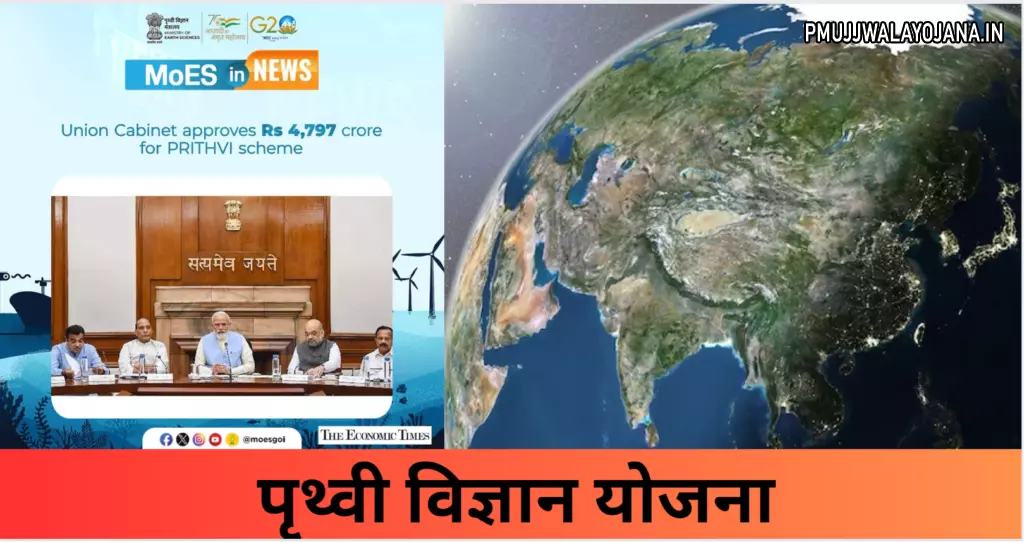Prithvi Vigyan Yojana 2025 is a new scheme focused on improving how we predict natural disasters like floods, earthquakes, tsunamis, and storms. It also aims to explore marine and polar resources through advanced earth science research in India. The central government has approved a budget of Rs. 4797 crore for this scheme during a cabinet meeting led by Prime Minister Narendra Modi.
This scheme is an important step in boosting India’s capabilities in earth system science. It covers main areas like climate, polar science, ocean services, earthquake science, and more. By improving disaster forecasting and management, it plans to protect lives and property across the country.
Keep reading to know more about Prithvi Vigyan Yojana, its main goals, important parts, and which institutions will help make this plan a reality.

Overview of Prithvi Vigyan Yojana
This scheme aims to develop systems that record important signals of earth system changes, helping predict and manage natural disasters better. It encourages integrated multidisciplinary earth science research and new programs in various organizations.
The government has approved Rs. 4797 crore for a 5-year period to support this plan. It will focus on combined research and development in areas like weather, climate, ocean, cryosphere (Earth’s frozen regions), seismology, and more.
The scheme also supports the discovery and sustainable use of living and non-living resources through better understanding and management of earth systems.
Know more about innovative space programs at the Apna Chandrayaan Portal.
Main Goals of Prithvi Vigyan Yojana
The scheme aims to increase and maintain long-term observations of the atmosphere, ocean, land, and solid Earth to record important changes in earth systems.
It works on developing modelling systems to better understand and predict the weather.
Exploring polar and deep-sea areas will help find new events and resources.
It also focuses on developing technologies to discover and sustainably use marine resources for social benefits.
Knowledge gained will be used for social, environmental, and economic benefits through various services under this scheme.
On January 5, 2024, the Union Cabinet approved the PRITHvi VIgyan (PRITHVI) schemes with an estimated cost of Rs. 4,797 crore, under the leadership of Hon’ble PM Shri @narendramodi ji. This includes important subschemes like #ACROSS, #OSMART (O-SMART), #PACER, #SAGE, and #REACHOUT. pic.twitter.com/HDlYVkjR1c — MoES GoI (@moesgoi) January 6, 2024
Main Features of Prithvi Vigyan Yojana
To provide trusted services and improve understanding of earth system science, the scheme has five major parts that depend on each other:
- Polar Science and Cryosphere Research (PACER)
- Seismology and Geosciences (SAGE)
- Research, Education, Training and Outreach (REACHOUT)
- Atmosphere and Climate Research Modelling Observing System (ACROSS)
- Ocean Services, Modelling Application, Resource and Technology (O-SMART)
To know more about India’s space curiosity, visit the ISRO Antriksh Jigyasa portal.
Instructions Given to the Ministry of Earth Sciences
The Ministry of Earth Sciences (MoES) is responsible for providing services related to weather, climate, ocean, coastal states, hydrology, seismology, and disaster management that benefit society.
The ministry is also directed to explore Earth’s three poles – Antarctica, Arctic, and Himalayan regions.
It has been instructed to work with various agencies and state governments to protect people and properties from natural disasters through effective methods.
Institutes Helping the Ministry of Earth Sciences
Ten important institutions assist the ministry in different research and service areas. They are:
- India Meteorological Department (IMD)
- National Centre for Coastal Research (NCCR)
- National Centre for Seismology (NCS)
- National Institute of Ocean Technology (NIOT)
- National Centre for Earth Science Studies (NCESS)
- National Centre for Polar and Ocean Research (NCPOR)
- Indian National Centre for Ocean Information Services (INCOIS)
- National Centre for Medium Range Weather Forecasting (NCMRWF)
- Centre for Marine Living Resources and Ecology (CMLRE)
- Indian Institute of Tropical Meteorology (IITM)
Frequently Asked Questions (FAQs) about Prithvi Vigyan Yojana
What is Prithvi Vigyan Yojana?
This scheme focuses on understanding weather and earth system changes to better predict and manage natural disasters, as well as exploring living and non-living resources for India’s benefit.
What is the budget approved for Prithvi Vigyan Yojana?
The government has approved Rs. 4797 crore to run this scheme and reach its goals, starting in 2025.